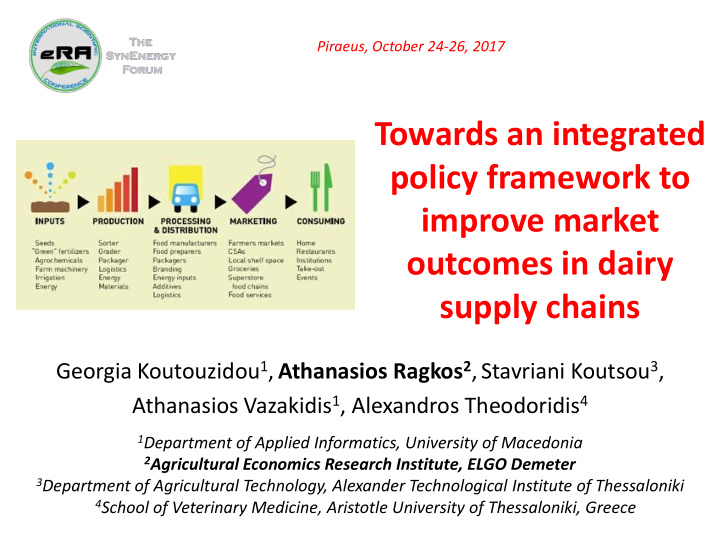



Piraeus, October 24-26, 2017 Towards an integrated policy framework to improve market outcomes in dairy supply chains Georgia Koutouzidou 1 , Athanasios Ragkos 2 ,Stavriani Koutsou 3 , Athanasios Vazakidis 1 , Alexandros Theodoridis 4 1 Department of Applied Informatics, University of Macedonia 2 Agricultural Economics Research Institute, ELGO Demeter 3 Department of Agricultural Technology, Alexander Technological Institute of Thessaloniki 4 School of Veterinary Medicine, Aristotle University of Thessaloniki, Greece
Purpose of the presentation • To describe the existing problems in the operation of the European food supply chains • To present relevant legislation in force and relevant actions that have been recently undertaken • To describe the current situation in the dairy cattle chain in Greece , which constitutes a typical case study • To propose a framework within which potential UTP, malpractices and the impact of other factors on its outcomes can be examined
Food supply chains in Europe • In Europe there is a huge diversity of small and big food supply chains – 110 retailers provide almost all European consumers with food, while 3 million farmers produce 3/4 of European food • Important challenges and information asymmetries – Insufficient price transmission mechanisms – Markets cannot achieve optimal performance - Price distortions – The position of producers is generally weak due to lack of bargaining power – Apart from collective actions further adjustments are needed to reverse the effects of the oligopolistic structure of food markets • Corporal practices are affected by national legislation, which differs between Member States, thus generating further distortions • Governments supervise these practices but cannot tackle all deviations • Consumers – Fair producer prices to ensure quality food at reasonable prices – Voluntary actions and societal demand for traceable products
The problem in the operation of food supply chains • Lack of transparency in the formation • Conflicts among actors of prices at all stages of the food • Farmers in a vulnerable position supply chain • Increased price volatility In order to improve the food supply chain • Promotion of sustainable and market-oriented relations between stakeholders • Increased transparency to contain price volatility and speculation • Strengthening the whole food market and the conditions of competition prevailing in all activities
Policies for transparent food supply chains • The imbalance among actors in the food supply chain illustrates the necessity to address the issue through policy measures – The problem is not only 'agricultural' but rather concerns all sectors of a country's economy, with social and environmental implications Unfair Trading Practices (UTP) affect the producer and limit consumer choices Delayed payments even more than 120 days from product delivery Refusal to accept written contracts/ Unilateral changes in contracts Shift of trading costs or risks to other actors, unilateral price reduction Barriers to entry for traders and producers • There are Market Observatories for specific products eg for milk • No common database providing comprehensive market information and revealing UTP
Policies to improve market outcomes • It is imperative to establish an common institutional framework at the EU level with common obligations for all Member States in order to restore balance in the food supply chain and to limit UTPs Resolution of the European Parliament The Taskforce for Agricultural Markets • Need to adopt measures tackling UTPs records the imbalance among actors in the • Not just a ‘moral’ call but rather a call food supply chain, recognizes the underlying for an integrated framework regulating food supply chains and ensuring fair reasons and suggests ways to tackle them treatment for producers and consumers • Support for market transparency in the EU • Risk management in primary production • Futures markets European Council of Ministers of • Tackling UTPs through an integrated framework Agriculture • “ Contractualization ” A set of conclusions concerning the empowerment of farmers’ position in • The CAP and Competition Law regarding the role the food supply chain and urging the of Producer Groups European Commission to adopt a • Better access of farmers to finance framework tackling UTPs
The example of the dairy supply chain in Greece
The Greek dairy supply chain – Production • Farms are rapidly growing • The number of farms is rapidly declining • New, entrepreneurial, well-organized, innovative farms • Only 40% of national demand is covered Farms Total milk production Average production Year Number Change (%) (th. ton) Change (%) (ton./farm) Change (%) 2006-2007 6270 736 117,4 2007-2008 5627 -10,3 716 -2,7 127,2 8,3 5074 -9,8 699 -2,4 137,8 8,3 2008-2009 2009-2010 4561 -10,1 682 -2,4 149,5 8,5 2010-2011 4259 -6,6 666 -2,3 156,4 4,6 2011-2012 3930 -7,7 642 -3,6 163,4 4,5 2012-2013 3686 -6,2 627 -2,3 170,1 4,1 2013-2014 3558 -3,4 615 -1,9 172,8 1,6 2014-2015 3356 -5,6 609 -0,9 181,5 5,0 2015-2016 3215 -4,2 605 -0,6 188,2 3,7 -3055 -48,7 -131 -17,8 70.8 60,3 Total change (decade) (%) Yearly rate of change (%) -6,5 -1,95 4,8
The Greek dairy supply chain – Processing • Greece produces only 0,45% of fresh milk in the EU • An oligopolistic sector – Six companies control 70% of the fresh cow milk sector in Greece (FAGE, DELTA, OLYMPOS-TYRAS, FRIESLANDCAMPINA (NOYNOY), MEVGAL, KRIKRI) – However there are at least 700 dairy industries in the country, some of which are of major importance at the regional/local level • DODONI (Epirus), EVROFARMA (Thrace), FARMA KOUKAKI (Central Macedonia), NEOGAL (Drama) – Cooperatives are gaining market shares e.g. THES GALA and EVOL in Thessaly
The Greek dairy supply chain – Retail sector • 80% of retail sales of dairy products are controlled by five supermarkets – METRO - MY MARKET, ΑΒ BASILOPOULOS, SKLAVENITIS, LIDL, MASOUTIS • “Private label” dairy products account for 6-7% of the whole market • 15% of the yoghurt market
FOOD TRACK VS/2016/0409 “A transparent and traceable food supply chain for the benefit of workers, enterprises and consumers: the role of a multi-sectoral approach of industrial relations and corporate social responsibility” An integrated examination of price transmission mechanisms
Recommend
More recommend